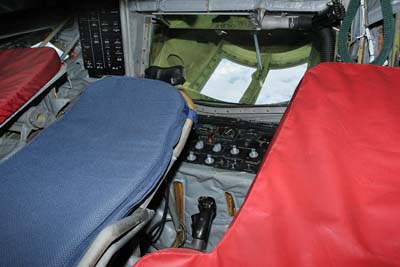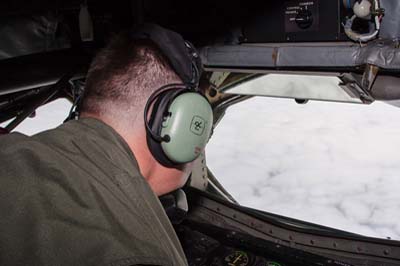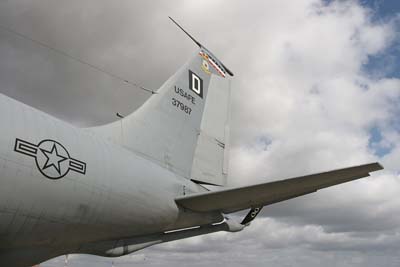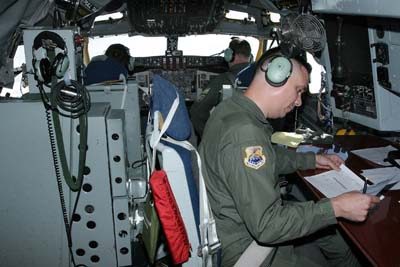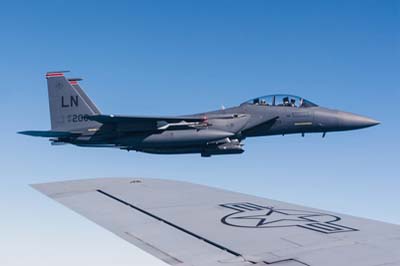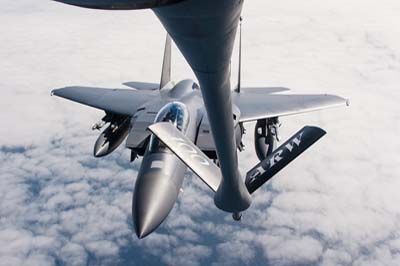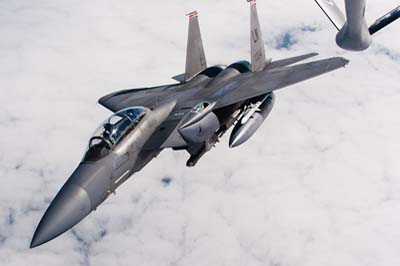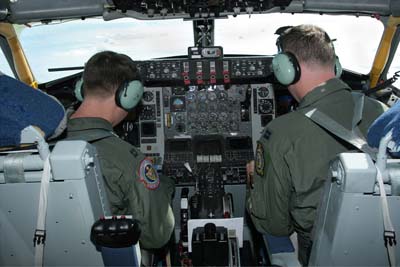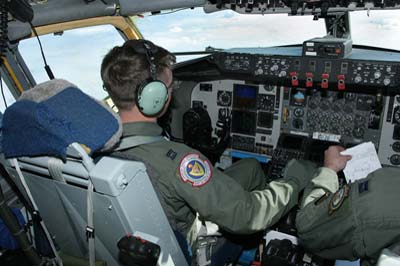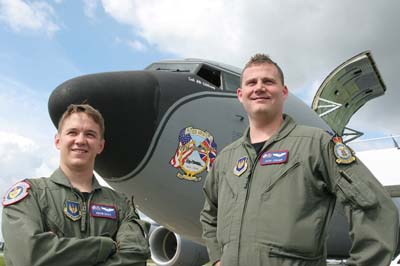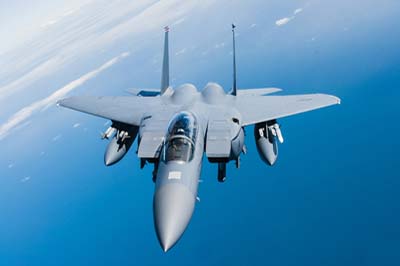KC-135 Stratotanker's 50th Anniversary
RAF Mildenhall
August 31, 2006
|

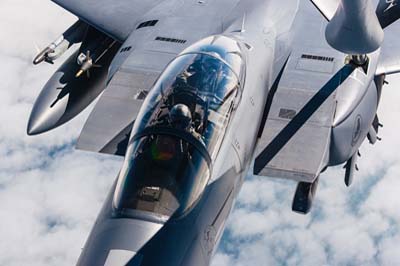 The United States Air Force is required to carry out operations across the world, often with very little notice. A vital component of the Air Force is it's 500 strong air refuelling fleet of Boeing KC-135 Stratotanker aircraft. With the first flight of this much-loved aircraft was on August 31, 1956 the Air Force were keen to celebrate its 50th anniversary.
The United States Air Force is required to carry out operations across the world, often with very little notice. A vital component of the Air Force is it's 500 strong air refuelling fleet of Boeing KC-135 Stratotanker aircraft. With the first flight of this much-loved aircraft was on August 31, 1956 the Air Force were keen to celebrate its 50th anniversary.
The main anniversary show was held at the KC-135 maintenance centre at Tinker Air Force Base in Oklahoma on September 8-9. RAF Mildenhall, the home of 100 Air Refuelling Wing (ARW) and 351st Air Refuelling Squadron, was keen to not miss out on the occasion and so held a modest media event on August 30. This included a presentation, drinks, cake and most importantly a demonstration air refuelling mission with eight of Lakenheath's Boeing F-15E Strike Eagles from 48th Fighter Wing, 494th Fighter Squadron. |
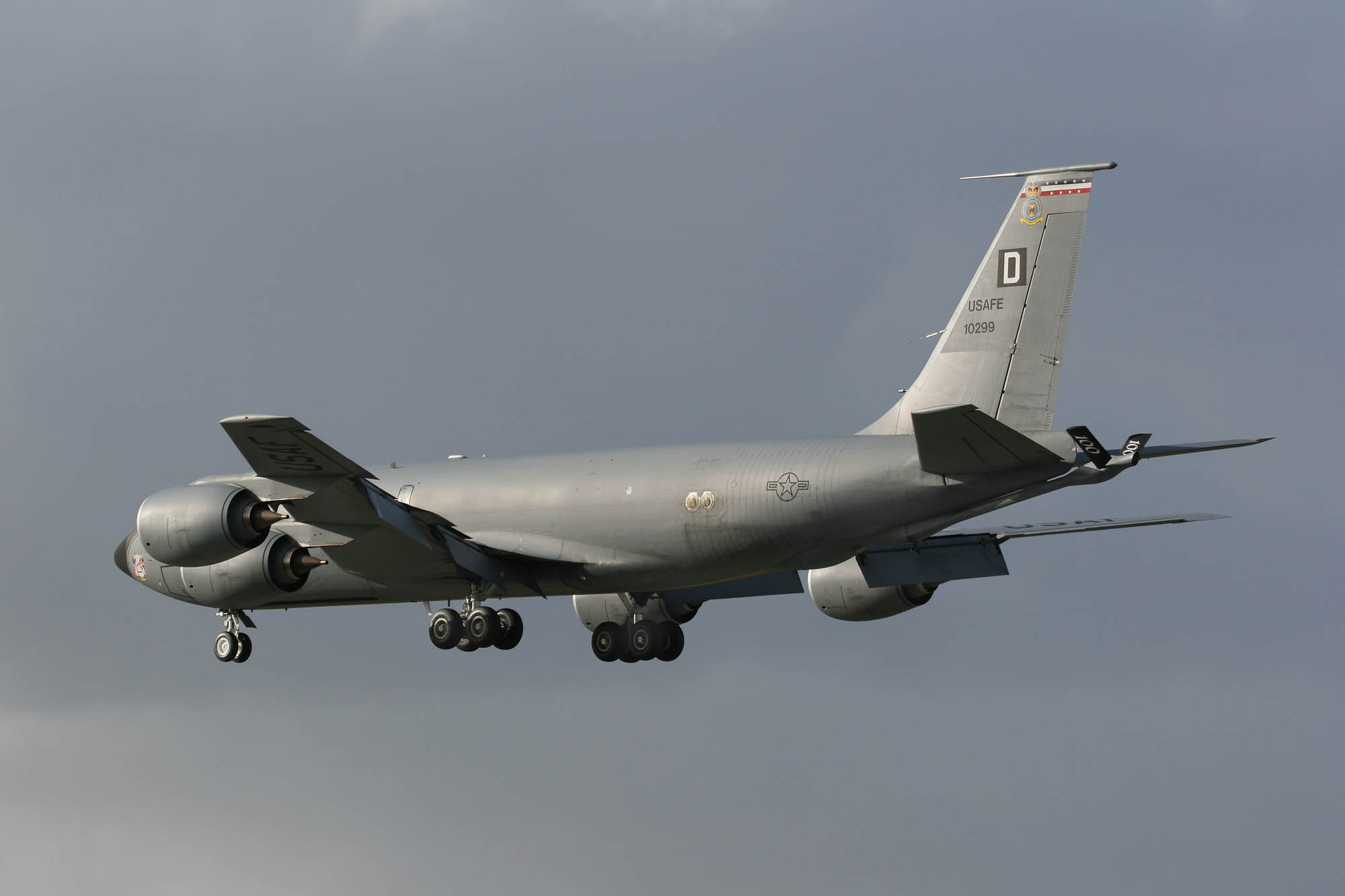 |
KC-135R (61-0299) of 100 ARW returns to Mildenhall.
The Square 'D' is a symbol which dates back to the World War Two when used by the 100th Bombardment Group (Heavy)
when flying the B-17 Flying Fortress. 100 ARW is the only USAF squadron authorised to carry its former war-time markings. |
Colonel David Callis, Vice Commander 100 ARW opened the presentation and stated that; "The KC-135 has provided day and night in-flight refuelling in all weathers for the last fifty years and will continue to do so. The air refuelling tanker serves as a critical player in our daily air operations around the globe." Colonel Callis, who obviously was proud of his aircraft, later went on to say that; "Dad flew the KC-135 when it was new, we have the same tail numbers in our log books."
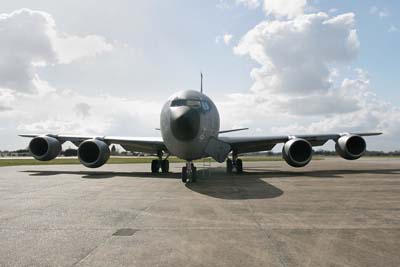
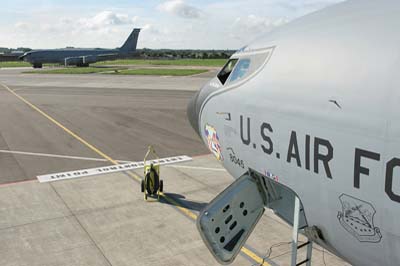 Major Russ Davies an instructor pilot at Mildenhall said; "There are no shortage of impressive statistics and facts that go to show how outstanding the KC-135 is. It can carry 200,000 pounds (91,000 Kgs) of fuel and can fly for 20 hours without refuelling. 6,000 pounds (2,722 Kgs) of fuel a minute can be off-loaded. To put this in perspective, an average car can run on the same amount of fuel a KC-135 dispenses in just one minute." He added; "Last year was a busy year for 100 ARW. In 2005/6 we flew 3,356 sorties and off-loaded 98 million pounds (44 million Kgs) of fuel." 100 ARW has the capability to off-load 124,000 gallons (564,000 litres) of fuel per day.
Major Russ Davies an instructor pilot at Mildenhall said; "There are no shortage of impressive statistics and facts that go to show how outstanding the KC-135 is. It can carry 200,000 pounds (91,000 Kgs) of fuel and can fly for 20 hours without refuelling. 6,000 pounds (2,722 Kgs) of fuel a minute can be off-loaded. To put this in perspective, an average car can run on the same amount of fuel a KC-135 dispenses in just one minute." He added; "Last year was a busy year for 100 ARW. In 2005/6 we flew 3,356 sorties and off-loaded 98 million pounds (44 million Kgs) of fuel." 100 ARW has the capability to off-load 124,000 gallons (564,000 litres) of fuel per day.
The KC-135 is able to refuel all types of Air Force and Navy aircraft and up to 35 aircraft in one mission. 100 ARW's operations range from bringing fighters (Coronet missions) over the Atlantic to Medivac flights to Africa as well as providing air refuelling training for all NATO allies on a regular basis. "We also refuel our bombers", said Major Davies, adding, "This is a key capability, allowing us to strike anywhere in the world. During operation 'Iraqi Freedom' a B-2 Spirit flew for 40 hours straight with over 20 refuelling operations, between Whiteman AFB in Missouri to Iraqi and back."
For almost all strike operations air refuelling plays a vital part. 100 ARW is often called upon to support military operations from Europe to Asia and across Africa. During the initial strikes of operation 'Iraqi Freedom' which ran from March 19, 2003 to April 26, 2003 100 ARW aircraft and crews flew 1,100 sorties and off-loaded 43 million pounds (20 million Kgs) of fuel to 4,600 coalition aircraft.
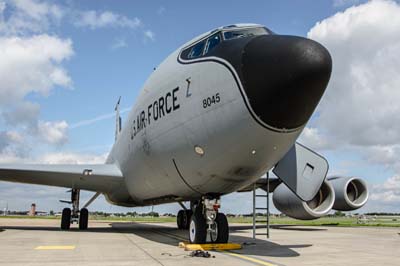
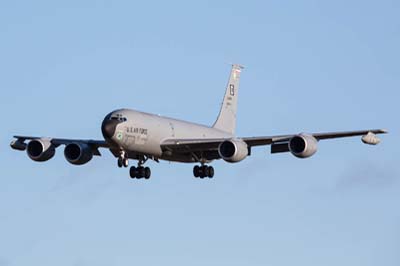 During the briefing a number of 100 ARW crewmembers were keen to discuss the KC-135 and it's missions. Captain Ryan Wilson a KC-135 pilot for eight years with 2,400 hours is now an evaluator pilot and has seen some changes over the years. The aircraft's avionics have improved considerably including recently added GPS equipment, a navigator is no longer a necessity. "We can now position the aircraft to within two meters making rendezvous accurate to within 2 seconds", said Capt. Ryan. Of his job, he clearly loved it, saying that he has the, "Best office window in the world."
During the briefing a number of 100 ARW crewmembers were keen to discuss the KC-135 and it's missions. Captain Ryan Wilson a KC-135 pilot for eight years with 2,400 hours is now an evaluator pilot and has seen some changes over the years. The aircraft's avionics have improved considerably including recently added GPS equipment, a navigator is no longer a necessity. "We can now position the aircraft to within two meters making rendezvous accurate to within 2 seconds", said Capt. Ryan. Of his job, he clearly loved it, saying that he has the, "Best office window in the world."
MSgt Mike Connor is the longest serving flyer with 100 ARW and has notched up 21 years as a boom operator. He said that; "I like what I do, but I guess I have more miles behind me than in front." Speaking of the many changes he has seen with the KC-135, he recalled how the original KC-135As used 5,581 pounds (2,532 kgs) of water that was injected in to the engine for the first two minutes of take-off to give an essential boost. "This was a sound you were always aware of during take-off", he said. Another key change was losing the necessity for a navigator; the boom operator now has more responsibility to assist the pilots. Talking of his most memorable mission he remembered back to a sortie in support of operation 'Iraqi Freedom'. When in a 'very dangerous place' during a thunderstorm they had to refuel F-15s whilst in a constant 30 degree turn. "You are not often aware of the threats till after the event and that it could have been ugly."
Staff Sargeant Marcuson has worked on the KC-135 for the last twelve years said; "Most of our daily work is preventative maintenance. We want to make sure that there are no problems in flight. We change parts after a set period of time. When we do get a fault reported to us, then a working group is put together to brainstorm the problem and come up with a solution." |
| Above: The Boom operator's position he manouevres the boom while lying on his stomach using a joystick from the central (blue mat) position. The red mats in the image can be used by photographers. The boom operator is in radio contact with his receivers. With the reduction of the crew down to three, due to a navigator being no longer necessary he will spend more time in the cockpit assisting the pilots. |
Training requirements for F-15 pilots at nearby RAF Lakenheath, dictate that a certain amount of time is required for air to air refuelling and as the tankers need the training also, both benefit in this symbiotic relationship.
Left to right: F-15E Strike Eagles of 48th FW / 494th FS (01-2003 'LN', 01-2002 'LN' callsign 'Rico 42' and 91-0334 'LN' callsign 'Rico 41'). |
| Seconds before touch down at RAF Mildenhall, with Capt. Kevin Dacy at the controls. |
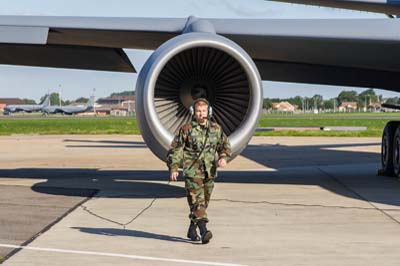 808 KC-135s were built by Boeing at their Seattle plant, the last was delivered in 1965 and over the last fifty years it has been a recipient of several upgrades. Between 1975 and 1988 Boeing replaced the lower wing skins to extend the service life to beyond 2020. In 1981 work began on replacing the KC-135A's noisy and smoky Pratt and Whitney J57-P-59W turbojet engines with refurbished former Boeing 707 TF33-PW-102 engines. The 160 re-engine aircraft were redesignated KC-135Es.
808 KC-135s were built by Boeing at their Seattle plant, the last was delivered in 1965 and over the last fifty years it has been a recipient of several upgrades. Between 1975 and 1988 Boeing replaced the lower wing skins to extend the service life to beyond 2020. In 1981 work began on replacing the KC-135A's noisy and smoky Pratt and Whitney J57-P-59W turbojet engines with refurbished former Boeing 707 TF33-PW-102 engines. The 160 re-engine aircraft were redesignated KC-135Es.
Later Boeing fitted 400 aircraft with CFM International's CFM56 engine, which offered even greater fuel efficiency. The KC-135R as they were designated were upgraded from 1984. The KC-135R can offload 50% more fuel, is 25% more fuel efficient and is 25% cheaper to operate, whilst being 96% quieter than the original KC-135As.
Left: A member of the groundcrew walks in front of the newer CFM56 engine. |
From all the discussions I had it was clear that all 100 ARW crews, staff and engineers were very fond of their fifty year old KC-135s and were happy to continue maintaining and flying them for many years to come.
Right: F-15E Strike Eagle from 48th FW, 494th FS (01-2003 'LN') approaches to within 30 feet of the air refuelling tanker. Note that the opening to his refuelling recepticle is open ready for the boom operator to insert the probe. It is not necessary to be straight and level, as you can see in the image above we are both turning at around 30 degrees to port. |
F-15E Strike Eagle (01-2003 'LN') of 494th FS, the WSO can sit back and relax during refuelling.
(DSLR x1.6 sensor + Canon EF 28-135mm (38mm) 1/320 f8). |
| A special thanks must go to Capt. Tisha Wright and the crew of 100 ARW KC-135R (63-8045), Capt. Kevin Dacy and Capt. Josh Jensen (above) and boom operator MSgt. Nathan Ragan for making our flight informative and safe. |

